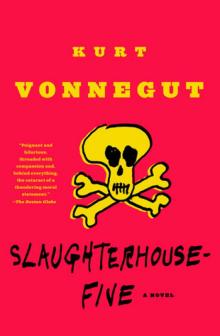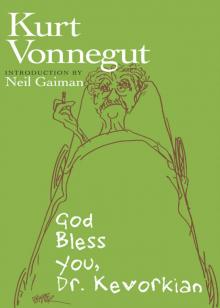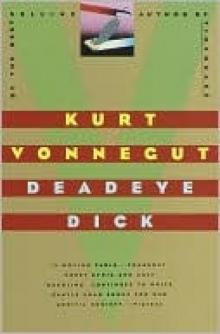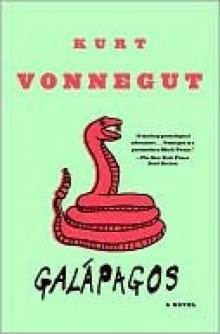- Home
- Kurt Vonnegut
Fates Worse Than Death: An Autobiographical Collage (Kurt Vonnegut Series) Page 11
Fates Worse Than Death: An Autobiographical Collage (Kurt Vonnegut Series) Read online
Page 11
“Hitler dreamed of killing Jews, Gypsies, Slavs, homosexuals, Communists, Jehovah’s Witnesses, mental defectives, believers in democracy, and so on, in industrial quantities. It would have remained only a dream if it hadn’t been for chemists as well educated as my brother, who supplied Hitler’s executioners with the cyanide gas known as Cyklon-B. It would have remained only a dream if architects and engineers as capable as my father and grandfather hadn’t designed extermination camps—the fences, the towers, the barracks, the railroad sidings, and the gas chambers and crematoria—for maximum ease of operation and efficiency. I recently visited two of those camps in Poland, Auschwitz and Birkenau. They are technologically perfect. There is only one grade I could give their designers, and that grade is A-plus. They surely solved all the problems set for them.
“Yes, and that is the grade I would have to give to the technicians who have had a hand in the creation of the car bombs which are now exploding regularly in front of embassies and department stores and movie theaters and houses of worship of every kind. They surely solve the problems set for them. Ka-blooey! A-plus! A-plus!
“Which brings us to the differences between men and women. Feminists have won a few modest successes in the United States during the past two decades, so it has become almost obligatory to say that the differences between the two sexes have been exaggerated. But this much is clear to me: Generally speaking, women don’t like immoral technology nearly as much as men do. This could be the result of some hormone deficiency. Whatever the reason, women, often taking their children with them, tend to outnumber men in demonstrations against schemes and devices which can kill people. In fact, the most effective doubter of the benefits of unbridled technological advancement so far was a woman, Mary Wollstonecraft Shelley, who died 134 years ago. She, of course, created the idea of the Monster of Frankenstein.
“And to show you how fruity, how feminine I have become in late middle age: If I were the President of MIT, I would hang pictures of Boris Karloff as the Monster of Frankenstein all over the institution. Why? To remind students and faculty that humanity now cowers in muted dread, expecting to be killed sooner or later by Monsters of Frankenstein. Such killing goes on right now, by the way, in many other parts of the world, often with our sponsorship—hour after hour, day after day.
“What should be done? You here at MIT should set an example for your colleagues everywhere by writing and then taking an oath based on the Hippocratic Oath, by which medical doctors have been bound for twenty-four centuries. Do I mean to say that no physician in all that time has violated that oath? Certainly not. But every doctor who has violated it has been correctly branded a scumbag. And why has the late Josef Mengele become the most monstrous of all the Nazis, in the opinion of most of us? He was a doctor, and he gleefully violated the Hippocratic Oath.
“If some of you elect to act on my suggestion, to write a new oath, you will of course have to examine the original, which is conventionally dated 460 years before the birth of Jesus Christ. So it is a musty old Greek document, much of it irrelevant to a physician’s moral dilemmas in the present day. It is also a perfectly human document. No one has ever suggested that it came from a god in a vision or on clay tablets found on a mountaintop. A person or some people wrote it, inspired by nothing more than their own wishes to help rather than harm humankind. I assume that most of you, too, would rather help than harm humankind, and might welcome formal restraints on what a wicked boss might expect of you.
“The part of the Hippocratic Oath which needs the least editing, it seems to me, is this: ‘The regimen I adopt shall be for the benefit of my patients, according to my ability and judgment, and not for their hurt or for any wrong. I will give no deadly drug to any, though it be asked of me, nor will I counsel such.’ You could easily paraphrase this so as to include not just doctors but every sort of scientist, remembering that all sciences have their roots in the simple wish to make people safe and well.
“Your paraphrase might go like this: ‘The regimen I adopt shall be for the benefit of all life on this planet, according to my own ability and judgment, and not for its hurt or for any wrong. I will create no deadly substance or device, though it be asked of me, nor will I counsel such.’
“That might make a good beginning for an oath everyone would gladly take upon graduation from MIT. And there is surely more than that you would gladly swear to. You could take it from there.
“I thank you for your attention.”
What a flop! The applause was polite enough. (There were many Oriental faces out there. Who knows what they may have been thinking?) But nobody came up front afterward and said he or she was going to take a shot at writing an oath all technical people would be glad to take. There was nothing in the student paper the next week. It was all over. (If such a speech had been given at Cornell when I was a student there, I would have written an oath that very night whilst talking to myself. Then again, I had had lots of free time, since I was flunking practically everything.)
What makes the students of today so unresponsive? (Only this morning I, an old poop, got a letter asking me if I had any suggestions for a revision of the Pledge of Allegiance, and I answered by return mail: “I pledge allegiance to the Constitution of the United States of America, and the flag which is its symbol, with liberty and justice for all.”) I’ll tell you what makes the students so unresponsive. They know what I will never get through my head: that life is unserious. (Why not make Caligula’s horse a Consul?)
Before my great speech to the MIT students I talked to some of them about Star Wars, Ronald Reagan’s belief that laser beams and satellites and flypaper and who-knows-what could be linked together in such a way as to form an invisible dome no enemy missile could penetrate. They didn’t think there was any way it could be made to operate, but they all wanted to work on it anyway. (Why not make Caligula’s horse a Consul?)
XIII
When I studied anthropology long ago at the University of Chicago, my most famous professor was Dr. Robert Redfield. The idea that all societies evolved through similar, predictable stages on their way to higher (Victorian) civilization, from polytheism to monotheism, for instance, or from the tom-tom to the symphony orchestra, had by then been ridiculed into obscurity. It was generally agreed that there was no such ladder as cultural evolution. But Dr. Redfield said in effect, “Wait just a minute.” He said that he could describe to every fair-minded person’s satisfaction one (and only one) stage every society had passed through or would pass through. He called this inevitable stage and his essay on it “The Folk Society.”
First of all, a Folk Society was isolated, and in an area it considered organically its own. It grew from that soil and no other. The break between the living and the dead was indistinct, and bonds of kinship crisscrossed every which way. There was such general agreement as to what life was all about and how people should behave in every conceivable situation that very little was debatable.
Dr. Redfield gave a public lecture on the Folk Society in the springtime each year. It was popular, I think, because so many of us took it as scientific advice about how to find deep and enduring contentment: join or create a Folk Society. (This was back in the 1940s, remember, long before the communes and flower children and shared music and ideals of my children’s generation.) Dr. Redfield denounced sentimentality about life in Folk Societies, saying they were hell for anyone with a lively imagination or an insatiable curiosity or a need to experiment and invent—or with an irrepressible sense of the ridiculous. But I still find myself daydreaming of an isolated little gang of like-minded people in a temperate climate, in a clearing in a woodland near a lake (an ideal spot, by the way, for a daydreaming maiden to find herself the captrix of a unicorn). My son Mark would help found and bankroll such a commune in British Columbia, and later write about it in The Eden Express. (I said in my own Palm Sunday that sons try to make their mothers’ impractical dreams for themselves come true. Here was a case of a son’s making his father’s
impractical dream come true. It worked OK for a while.)
Realtors commonly imply that to buy or rent a house in such and such a locality will make the sucker eligible for virtually instant membership in a Folk Society. I had something like that in the back of my mind when I quit General Electric and moved to Cape Cod, where I lived for twenty years (Provincetown, then Osterville, then Barnstable). But I had no relatives there, and I wasn’t even an Anglo-Saxon or a descendant of seafarers or colonials. And very few of my ideas, frequently subject to public inspection in magazines and books, coincided with those of my neighbors. So I was as much an outsider when I left as I had been on the day I arrived. (Soon after I arrived I offered my services as a volunteer fireman, since I had been a fireman in Alplaus, New York, outside Schenectady. I might as well have been a freshman at Yale expressing a willingness to join Skull and Bones.)
Nor do I have any illusions that I am in any serious way a part of the picture-perfect village in which I am writing now, which is Sagaponack, Long Island. The Fire Department asks for money in a form letter to my PO box, and I send them some. My nearest neighbor is the painter Robert Dash, who boasts that his hedges are so thick he can’t see anything outside his own property. (Noises can still get through his hedges, though. One time Truman Capote spent the afternoon in my backyard, talking about himself, and Dash told me later that he thought I had been visited by a garrulous maiden aunt.)
(I expected this to be an easy chapter, that most of it would be another piece I wrote for Architectural Digest, entitled “Skyscraper National Park.” But that piece turned out to be so badly written that I am surprised they printed it. What made me garble it so, I think, was my undying fantasy that I would be a contented person if only I could become a member of a Folk Society. That is my Holy Grail, and I can’t stop believing, in defiance of all common sense, that it is mine to find somewhere. So this chapter has filets cut from the published essay, but they are not set apart by quotation marks, a cumbersome exercise in scholarship. Who cares anyway?)
I spend most of my time in Manhattan, across the street from the yellow house where E. B. White lived for many years. He and his wife Katherine, personifications (you would think) of all that was most cultivated and gracious and witty about Manhattan, bugged out for Maine a few years before I got there. (Maine! Maine? For Pete’s sake. Maine!)
It took a foreigner with whom I had no language in common to describe for me the peculiar ambience of Manhattan. He was the great Turkish novelist Ya?ar Kemal (who resembles a genuinely happy Ernest Hemingway, although he has been jailed again and again for crimes of conscience). He was in New York City for the first time, and he and I walked down Broadway from about Sixtieth Street to SoHo, with many side trips to the east and west. I showed him Edna St. Vincent Millay’s quaint house. I showed him Washington Square and said, “Henry James! Henry James!” (Just as I had exclaimed to him earlier, “Edna St. Vincent Millay! Edna St. Vincent Millay!” Proper names need no translator, although it is unlikely that Ya?ar Kemal had heard of either author.)
I had no idea what the Turk made of it all. But when he got back home (he would soon be back in the hoosegow for the umpteenth time) he wrote me a letter which his translator wife put into English. It said in part, “Suddenly I understood! New York belonged as much to me as to anyone as long as I was there!” And there you have the essence of the part of Manhattan I had walked him through, which I in my Architectural Digest piece called “Skyscraper National Park.”
There are people who go to great lengths to prove that they own some part of Skyscraper National Park, putting their names on buildings or whatever, but they might as well put their names on things like the Grand Canyon or Old Faithful (which will spout at your convenience if you pour a box of laundry detergent down the hole). Manhattan is a geological phenomenon. An enormous fraction of the planet’s wealth was concentrated on a little island of solid granite. This caused crystals to sprout in such profusion that the island when viewed from the air now resembles a quartz porcupine.
If I am ever going to find a Folk Society for myself (and time is growing short), it will not be on Manhattan. The members of such a society, Dr. Redfield taught me, must feel that a particular piece of land gave birth to them, and has been and always will be theirs. As I say, nobody can really own anything in Skyscraper National Park.
I have said in speeches that Dr. Redfield, by describing a Folk Society, deserved to be honored alongside the identifiers of vitamins and minerals essential to our good health and cheerful ness. Sailors in the British Navy used to feel lousy on long sea voyages because they weren’t getting enough vitamin C. Then they started sucking on limes and they felt OK again. (That is why we call British people limeys. Their sailors were thought to be ridiculous for sucking limes.) I have asserted that a lot of us were wasting away for want of a Folk Society. But vitamins and minerals are real, and Folk Societies, if any survive anywhere, are probably quack remedies for what ails people like me, on the order of Lydia E. Pinkham’s Vegetable Compound for Female Complaints.
I visited the Anthropology Department of the University of Chicago a few months ago. Dr. Sol Tax was the only faculty member from my time who was still teaching there. I asked him if he knew what had become of my own classmates (including Lisa Redfield, Dr. Redfield’s daughter). Many of them, Lisa, too, he said, were practicing what he called “urban anthropology,” which sounded an awful lot like sociology to me. (We used to look down on the sociologists. I couldn’t imagine why and can’t imagine why.) If I had stayed with anthropology as a career, I would now be doing, probably, what I am doing, which is writing about the acculturated primitive people (like myself) in Skyscraper National Park.
A vitamin or mineral deficiency always has bad effects. A Folk Society deficiency (hereafter “FSD”) quite often does. The trouble begins when a person suffering from FSD stops thinking, in order to become a member of an artificial extended family which happens to be crazy. The homicidal “family” of Charles Manson springs to mind. Or what about the cult of the Reverend Jim Jones in Guyana, whose members on his advice (“Tonight you will be with me in Paradise”) fed the kids Kool-Aid laced with cyanide and then drank it themselves. (The Reverend Jones, like Manson, was from Indianapolis. I didn’t tell John Updike that before his lecture there. I had already given him enough information about a city he would probably never see again. Why send him out there with an overload?) And there is the Ku Klux Klan (whose national headquarters was in Indiana when I was a little boy). And there is the National Rifle Association. And there are all those people who exhibit weirdness if they work in the White House for very long.
Every cockamamie artificial extended family of FSD sufferers resembles Redfield’s Folk Society to this extent: it has a myth at its core. The Manson family pretended to believe (the same thing as believing) that its murders would be blamed on blacks. Los Angeles would then be purified somehow by a race war. The myth at the core of the political family which calls itself “Neo-Conservatives” isn’t that explicit, but I know what it is, even if most of them can’t put it into words. This is it: They are British aristocrats, graduates of Oxford or Cambridge, living in the world as it was one hundred years ago.
Did anyone back then ever look more worn-out by the White Man’s Burden than do William F. Buckley, Jr., and our former Representative at the United Nations Jeane Kirkpatrick in the present day? What to do about the Hottentots?
This delusion is in most cases comical. But it has also been tragical for dark-skinned poor people not just in this country but in many, many other parts of the world, since the Neo-Cons have been so influential in shaping our foreign policy during the past ten years. Never mind domestic policy. Foreign policy got all the money.
I mean, my goodness, at one point they had our battleship fire salvos into Lebanon, with no particular targets in mind. That was a scene straight out of Joseph Conrad’s Heart of Darkness. That book was published way back in 1902, when the idea that upper-class white peo
ple were the most highly evolved animals on Earth, and that poor people and dark people were monkeys without tails, had yet to be discredited. The Neo-Cons had our planes fire rockets at monkeys without tails in Tripoli (hitting, among other things, Qaddafi’s daughter and the French Embassy). They had us kill maybe one thousand monkeys without tails in the process of arresting one monkey without a tail, the Head of State, in Panama. And there are all these other gruesome things we did or are still doing to monkeys without tails in Guatemala and E1 Salvador and Nicaragua and the South Bronx and Mozambique, and who knows where else? (“Only the Shadow knows.”)
Who but an organ grinder cries when a monkey dies? Not even another monkey.
(Don Quixote was a Neo-Conservative in his time, but all he did was bust a sail on a windmill and scare some sheep.)
XIV
I tried to deal some with the Neo-Cons’ wrong-centuryism and wrong-countryism in a novel I finished four months ago, Hocus Pocus. The Franklin Library is (at this writing) preparing a deluxe edition of Hocus Pocus (with an illustration by my daughter Edith, the former Mrs. Geraldo Rivera, now married to a really great guy) for which I have provided a special preface.
It says that I, ever since studying anthropology, “have regarded history and cultures and societies as characters vivid as any in fiction, as Madame Bovary or Long John Silver or Leopold Bloom or who you will. A critic for The Village Voice announced in triumph sometime back his discovery that I was the only well-known writer who had never created a character, and that the next step should be to unfrock me on that account. He was incorrect, since Eliot Rosewater and Billy Pilgrim and some others of my invention are surely stereophonic and three-dimensional, and as idiosyncratic as you please. But he was onto something nonetheless: In many of my books, including this one, individual human beings are not the main characters.

 Slaughterhouse-Five
Slaughterhouse-Five Bagombo Snuff Box: Uncollected Short Fiction
Bagombo Snuff Box: Uncollected Short Fiction God Bless You, Dr. Kevorkian
God Bless You, Dr. Kevorkian Breakfast of Champions
Breakfast of Champions While Mortals Sleep: Unpublished Short Fiction
While Mortals Sleep: Unpublished Short Fiction Slapstick or Lonesome No More!
Slapstick or Lonesome No More! Cat's Cradle
Cat's Cradle The Sirens of Titan
The Sirens of Titan A Man Without a Country
A Man Without a Country Look at the Birdie: Unpublished Short Fiction
Look at the Birdie: Unpublished Short Fiction Bluebeard
Bluebeard Hocus Pocus
Hocus Pocus The Big Trip Up Yonder
The Big Trip Up Yonder Palm Sunday: An Autobiographical Collage
Palm Sunday: An Autobiographical Collage Jailbird
Jailbird Happy Birthday, Wanda June
Happy Birthday, Wanda June Welcome to the Monkey House
Welcome to the Monkey House Player Piano
Player Piano Fates Worse Than Death: An Autobiographical Collage
Fates Worse Than Death: An Autobiographical Collage Love, Kurt
Love, Kurt Timequake
Timequake God Bless You, Mr. Rosewater
God Bless You, Mr. Rosewater 2 B R 0 2 B
2 B R 0 2 B The Eden Express: A Memoir of Insanity
The Eden Express: A Memoir of Insanity Mother Night
Mother Night Deadeye Dick
Deadeye Dick Galápagos
Galápagos Palm Sunday
Palm Sunday We Are What We Pretend to Be
We Are What We Pretend to Be Look at the Birdie
Look at the Birdie Basic Training
Basic Training Armageddon in Retrospect
Armageddon in Retrospect Basic Training (Kindle Single)
Basic Training (Kindle Single) If This Isn't Nice, What Is?
If This Isn't Nice, What Is? Bagombo Snuff Box
Bagombo Snuff Box The Petrified Ants
The Petrified Ants Cat's Cradle: A Novel
Cat's Cradle: A Novel Fates Worse Than Death: An Autobiographical Collage (Kurt Vonnegut Series)
Fates Worse Than Death: An Autobiographical Collage (Kurt Vonnegut Series)